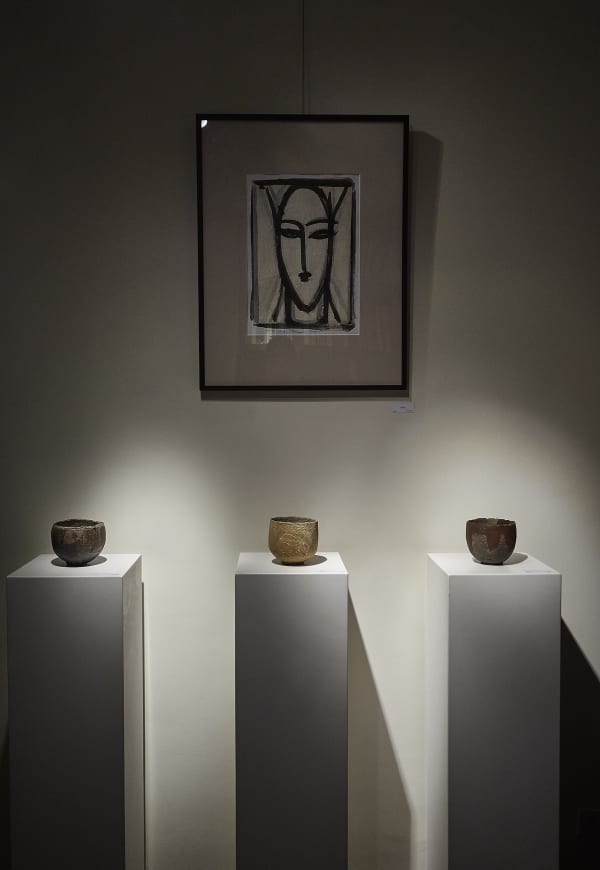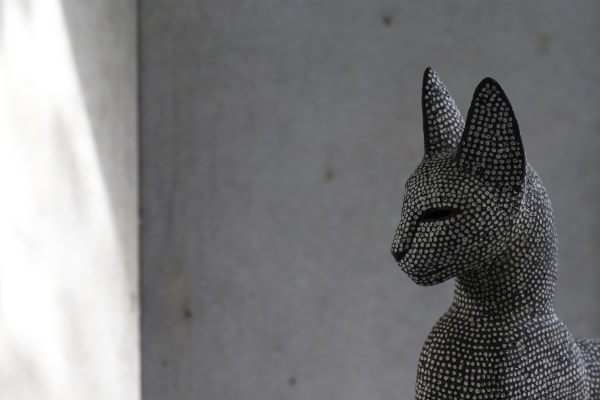Between Forms: The Terracotta Cosmos by Mokichi Otsuka
Endless Bonds
Shoko Aono
One day in late summer, I visited Mokichi Ōtsuka at his home in Yamanashi Prefecture. The evening cicadas called as a gentle breeze blew through the trees in the garden of his classical Japanese home, bringing with it a cool scent. The breeze blew past the translucent paper doors and into the room, creating a pleasant atmosphere. However, the moment I saw the lifelike, red, terracotta works, I was forced to pause. I asked myself, what country was I in? The sensation was strange.
After studying terracotta for five years (1994–1999) in Faenza, Italy, Ōtsuka became seriously ill. This brush with death took hold while traveling in Greece, he came across a statue of the goddess, Kore. Her gentle beauty seemed to encompass life, moving him deeply. Ever since, Ōtsuka has devoted himself to capturing the joy of life that resides within the divine woman’s form.
Later, in Nepal in 2016, he again faced a life-threatening condition. Ōtsuka felt as if he wereenshrouded in darkness deep under the earth, even as he was high in the mountains. As a result of this experience, he adopted the Asian philosophy of the harmonious coexistence of life and death.
In contrast to the quiet, feminine form works of the Greco-Roman world, he also creates images of cats that can be said to be emblematic his work. Overflowing with life, they appear on the verge of standing up to walk.
Subsequent to this, whether by chance or necessity, he began to make holes in the white inlay that covers all his works, and like the first cry of a newborn baby, this was the moment they came alive.
The unique individuality of his works brought about by these air holes results in them seemingly existing somewhere between East and West... sometimes even combining the two. They cannot be described as simply representing the pursuit of formative beauty or spiritual expression. The stippling is not applied as decoration--rather, it is his way of interacting with the form he has made, gently drilling the holes one by one to allow the light to pass as an act of devotion. Denial and affirmation, death and life, internal and external, dark and light—opposites mix and circulate through these air holes. Ōtsuka’s works create a mysterious undulation, comprising of endless yearning for the beauty of life. Their eyes gaze upon emptiness, forever locked in physical surprise, poetic sentiment, and the laws of the universe.
This exhibition will be the first solo exhibition of Ōtsuka’s work to be held in New York and willpresent new works that he has created both in Yamanashi and Faenza. These terracotta prayers created by Mokichi Ōtsuka will spread across the world, eternally.
They remind me of this poem that I would like to dedicate to him:
The great is to be found in the small,
The infinite within the bounds of form,
And the eternal freedom of the soul in love.
Rabindranath Tagore (b. India 1861–1941)
Ippodo Gallery is pleased to present terracotta works by Mokichi Otsuka (b. 1956), displayed from September 6 to 28, 2018.
Explorations of form take shape with two recurrent motifs—predominately women and cats. Female heads, busts and hands bear reference to the Greco-Roman tradition of seeking an idealized womanly figure in a three-dimensional world, and the terracotta medium to the history of pottery and its life-bearing properties. Under the tutelage of Italian sculptor Aldo Rontini in Faenza, Italy, Otsuka was encouraged to harness the power of ancient traditions through ceramic tiles. Following five years of illness, a chance encounter with the ancient Greek goddess Kore solidified his interest in the seemingly inexpressible vitality of humanity, and eternal fascination with Western heritage.
And yet, Otsuka’s work takes on a contemporary relevance in its homage to Eastern traditions, in that it looks inward. Particularly in the new cat works, sharp, long eyes bear reference at once to the hollowed and unattainable women of Modigliani paintings, Egyptian and Nepalese deities, and even the Noh masks of Japanese theater. Their ability to transcend art historical moments means that their fluidity succeeds in achieving its distance, personifying the value of life in Western antiquity while also encapsulating the unknowable inner life prevalent in Buddhist teachings.
As they bridge the worlds of Greco-Roman and Japanese art, Otsuka’s terracotta wares are unique. Even as the concepts endure, the artist deviates from prehistoric Japanese ceramic aesthetics and their contemporary experimentational counterparts. Pieces are fired at 1060°Celsius (1940° Fahrenheit), in an entirely unique process he continues to innovate. Most recently, he has developed a deeply symbolic and significant perforation technique.
What began as red clay inlaid with white dots has evolved to perforations in white clay. Naturally occurring cracks are left as part of the work to reveal its soul. These holes are a window to the cosmos, undulating in patterns and creating a passage between worlds. They symbolize nature’s energy, encapsulating the inexpressible theories crescendoing in each work of art.
Otsuka has found solace in the expression of mind and body through his works. He pursued extensive education to expand his universe, first in Japanese painting at the graduate school of Tokyo National University of Fine Arts and Music (present- day Tokyo University of Art) in 1981, and later at the Istituto Statale d’Arte per la Ceramica Gaetano, in Faenza, Italy in 1994, where he has continued to exhibit annually since 2006.
As such, Otsuka’s unique fusion of cultural influences has been exhibited namely in the regions where he has drawn inspiration: his home country of Japan, and his beloved Italy. He has held solo exhibitions throughout Japan and Italy, as well as at the 4th Ceramics Biennale in Cairo, Egypt, in 1998. Ippodo is happy to announce that this is the first Mokichi Otsuka show in New York City.
This exhibition also marks a transformation in the ethos of Ippodo Gallery. The message of the gallery has always been in sync with the natural world, but increasing diplomatic engagements are solidifying its place in the canon of cross-culturalism. May this exhibition be a continue culmination of exchange of Japanese culture with the Western world.

























